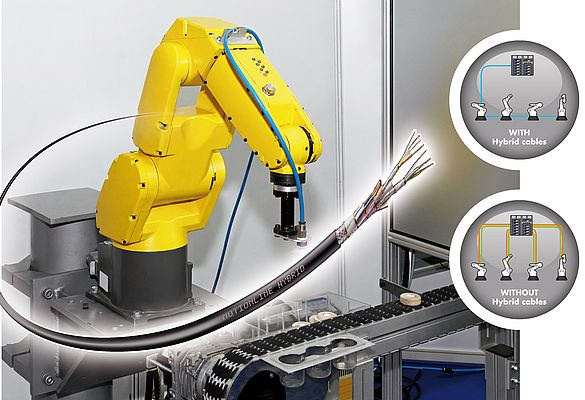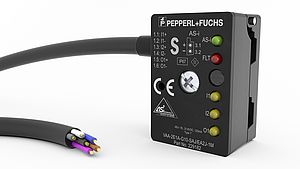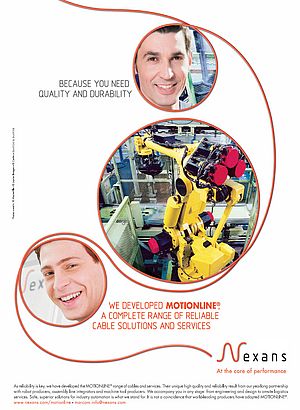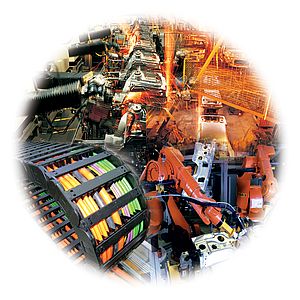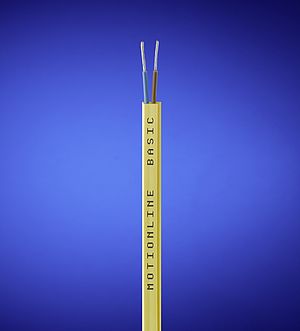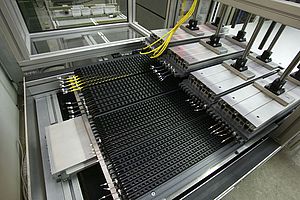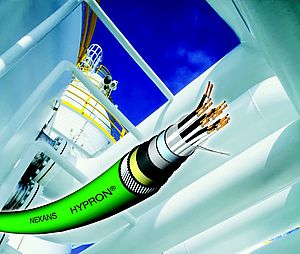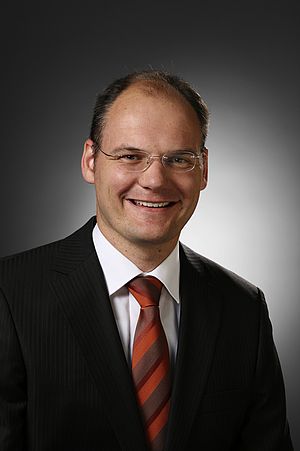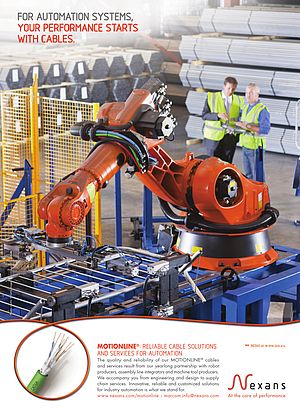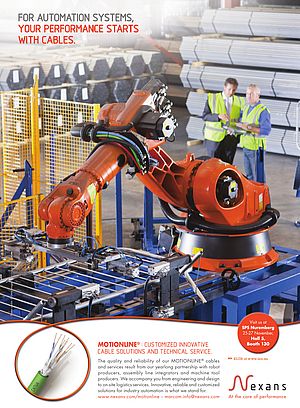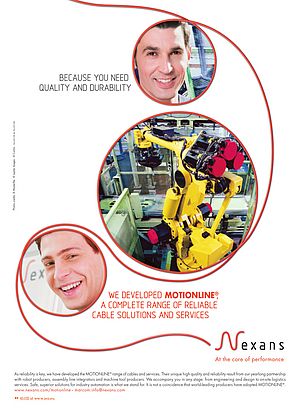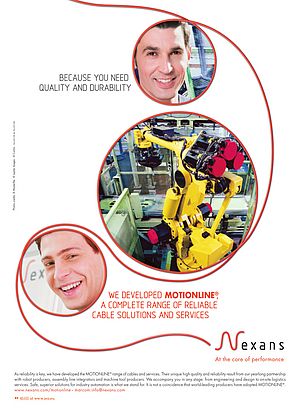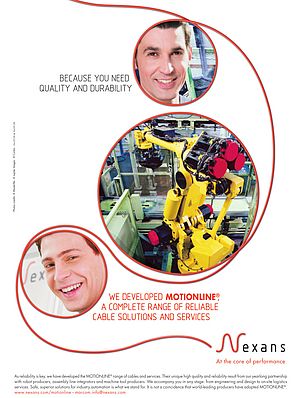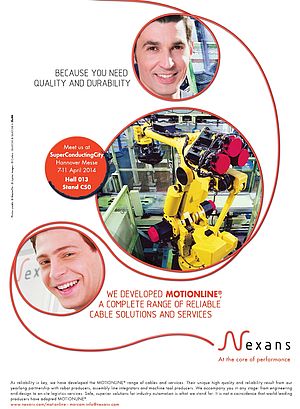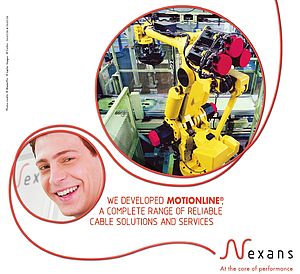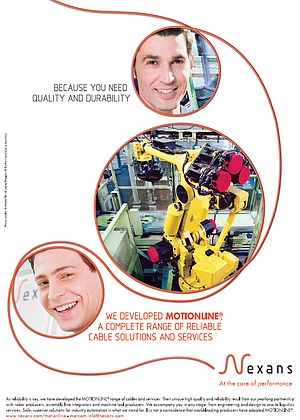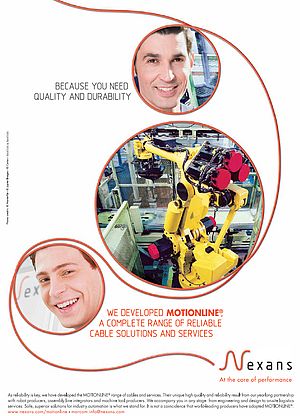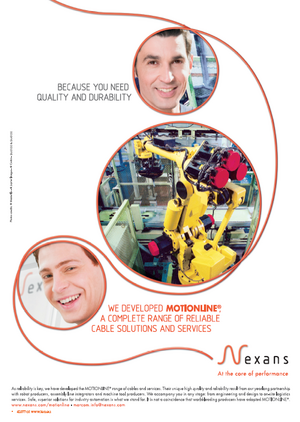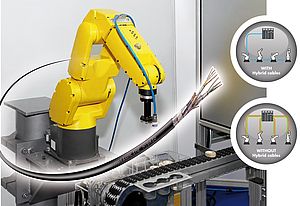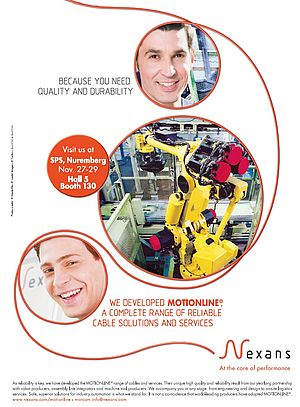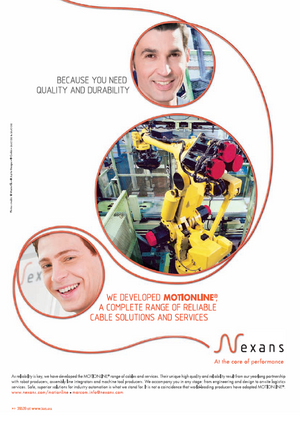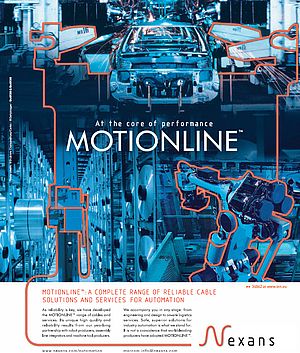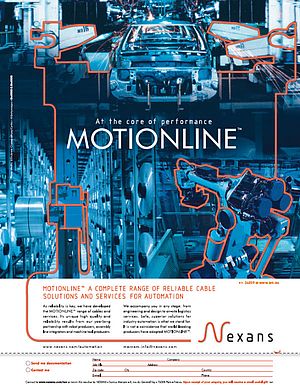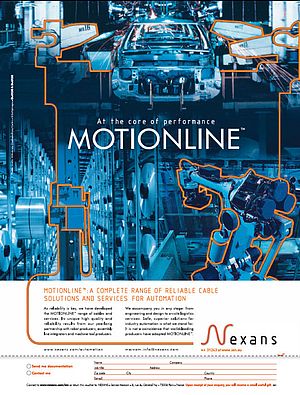Manufacturing industry is changing rapidly. Now, instead of manufacturers setting up their automated production lines and expecting them to run virtually unchanged year-on-year, flexibility is the new watchword. This is reflected in the growing demand for flexible automation systems that can be readily reconfigured and expanded to meet changing needs with minimum complication and expense. Nexans has responded to this trend by expanding its well proven MOTIONLINE® range of automation cables to include a new generation of sophisticated, high-tech hybrid cable solutions.
The key advantage of these new hybrid cables is that they integrate the individual power, data and signal transmission functions required by automation equipment within a single cable. This offers an innovative approach to the interconnection of equipment such as control cabinets and motors with a neat, space-saving installation that is both faster and easier than using individual cables for each function, and crucially it also ensures flexibility for future reconfiguration and expansion projects.
What is a hybrid cable?
A hybrid cable integrates a power supply application with at least one other key automation application within a single cable cross-section - it is important to note that a hybrid cable is not two or more different cross-sections. As an example, the hybrid cable will comprise a power cable and one or more of the following applications: signal, bus, sensor, control and POF (plastic optical fibre) cables.
Saving costs and improving efficiency
The traditional approach to the installation of automation equipment, such as servo motors or robots, is to use individual cables for each power, data and signal transmission connection between the control cabinet and the unit itself. This approach can be time-consuming and when there is a need to add additional units further cabling is necessary, while additional plugs and sockets may also need to be mounted on the cabinet.
The use of BUS-cables has already reduced this cable work by offering easy connection of each active component. Indeed, USB (Universal Serial Bus) cables are well known in the world of computers and mobile devices as a very simple and easily extendable system. Now, hybrid cables are taking the BUS-cable concept to the next level.
A typical hybrid cable application is to replace the traditional 'star' configuration, in which each automation unit is clustered around the control cabinet, with a de-centralized 'loop' or 'daisy-chain' configuration. Through-connection of the units with each other in this way, rather than running cables between the control cabinet and each unit, creates a simple, elegant and easy to clean and maintain system which is less time consuming in installation. A further important advantage is that the system is also easy to expand as the new units are simply plugged into the last in line of the existing units.
The adoption of hybrid cables does require the use of compatible cabinets, motors and controllers with the necessary connectors. However, suitable equipment is already available from major manufacturers such as Siemens, SEW Eurodrive, B&R, Beckhoff and Kollmorgen.
The number of units that can be connected together in this daisy-chain configuration varies according to the specific application. As an example, 7-8 motors rated at 2 kW might be chained together and controlled by a single unit, while around 30 motors rated at 400-500 W have been configured in one chain inside a labelling machine. Some applications have already seen 70 motors, each rated at 500 W, used for decentralized applications in many different areas of automation in the packaging and food industry, in conveyor systems, robots, assembly lines and machine tooling.
Bespoke solutions
Customers approaching Nexans for a hybrid cable solution are often surprised that there is currently no specific global standard that can be referenced. In fact, due to the wide variety of potential applications, hybrid cables are rarely available off the-shelf and a bespoke solution is usually required for each installation.
Because of Nexans' pioneering role in hybrid cables, it has developed a portfolio of more than 200 different designs. So it is possible that a customer might find a solution already developed to meet their specific needs.
Every hybrid cable comprises the following basic elements: one screened element for data transmission; at least two power conductors and one protective conductor; one to two signalling elements.
The whole cable needs shielding for protection against EMC (electromagnetic compatibility) and a TPU (thermoplastic polyurethane) sheath is recommended to ensure resistance against the various potentially damaging liquids and substances found in automation applications.
To overcome the challenge of a lack of a current standard, Nexans has created its own internal standards, so that the tailor-made hybrid cables are designed and tested according to the requirements of: UL standards; VDE approvals; homologation with BUS associations such as Profibus; sensor elements including Murr, Weidmuller and Belden; drives and controls such as Siemens, Bosch, SEW.
A key consideration in the development of hybrid cables is ensuring that they can handle the heat generated by the current flowing in the power element so that the temperature within the connector never exceeds the permitted level of +65°C. Nexans has successfully developed and tested hybrid cables capable of carrying 30 A with an AWG12 / 4.0 mm2 cross-section.
The MOTIONLINE® hybrid cables are classified in three categories: Basic - for fixed installations or with relatively limited movement; Advanced - for typical chain applications: Premium - for cables subjected to severe mechanical stresses.
Total system approach
While some OEM customers require only the hybrid cable, many are looking for a total system solution comprising the cable and the connector. Choice of the optimum connector is crucial to the success of any hybrid cable installation, so Nexans has provided extensive input to INTERCONTEC's development of a new generation of versatile hybrid connectors that offer outstanding reliability in a compact design. In contract to standard connectors designed for use with a large number of wires, connectors designed specifically for hybrid cables can be made much smaller and easier to manage and install.
An excellent example of INTERCONTEC's capability is a design for the daisy-chaining of servo motors that combines the auxiliary supply for operation, the intermediate higher voltage supply capable of handling peak voltages up to 850 V DC, an EtherCAT bus signal and an additional bus signal for system diagnosis in a single connector.
Saving installation costs
In addition to offering flexibility and upgradeability, hybrid cables can enable installers to achieve very significant cost savings. These will vary according to the specific application. However, considering just one example shows exactly what is possible.
Looking at the total cost of a cable solution (in units rather than a specific currency) based on a typical length of 10 metres:
For a standard harness
- About 30 to 40 percent of cost is the cable (40 units)
- About 30 to 35 percent of cost is the connector (30 units)
- About 25 to 30 percent of cost is the labour (30 units)
- Total 100 units
Installation of a machine requires at least one power harness and one encoder or bus harness
- Total 2 x100 = 200 units
Using a hybrid cable
- Cost of cable is approximately 20 percent higher (48 units)
- Cost of connector is approximately 20 percent higher (36 units)
- Cost of labour is approximately 20 percent higher (36 units)
- Total 120 units
Therefore, the cost saving using the hybrid solution is in the order of 40 percent.
Tested at the Nexans Motion Application Centre
Hybrid cables form part of Nexans' well established MOTIONLINE® brand of cable solutions developed specifically to deliver high-performance and total reliability in a wide variety of control chain, bus, sensor and robotic automation applications.
In common with all the MOTIONLINE® cables, the hybrid cables have been subjected to rigorous testing at the Nexans MAC (Motion Application Centre) in Nuremberg, Germany. This facility, unique in the cable industry, enables cables to be exposed to dynamic operating loads that simulate realistic, in-service, conditions, thus ensuring that they offer the ideal combination of bending, tension and torsional strength and vibration resistance required for their intended application. It provides clear proof that an automation cable will perform throughout its expected lifecycle as described in the relevant standard.
Nexans has been testing automation cables for some 20 years. The Motion Application Centre was established around 6 years ago and is the subject of considerable ongoing investment to reflect the changing needs of the automation industry, resulting in a current roster of 12 different machines designed to test cables to their limits. A key advantage of the facility is that it enables both the electrical and data performance of the automation cables to be monitored under dynamic loading conditions. In addition to the mechanical tests, environmental chambers also allow the cables to be subjected to varying environmental conditions.
Freedom, flexibility, fast connection
The creation of this new generation of hybrid cables is a perfect example of Nexans' focus on technical leadership to deliver innovative OEM solutions. They offer the ideal solution for any installer seeking freedom, flexibility and fast connection for their automation equipment.


